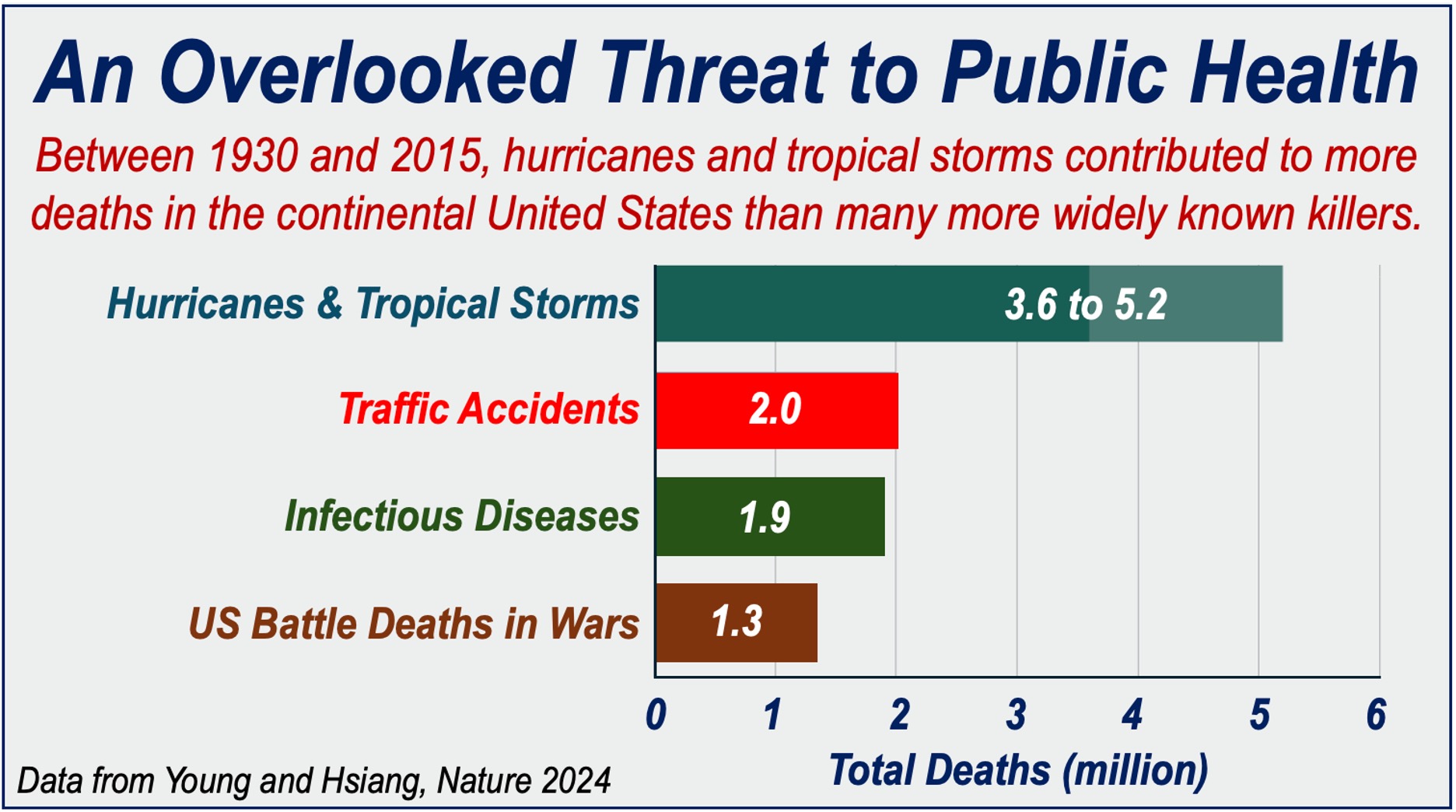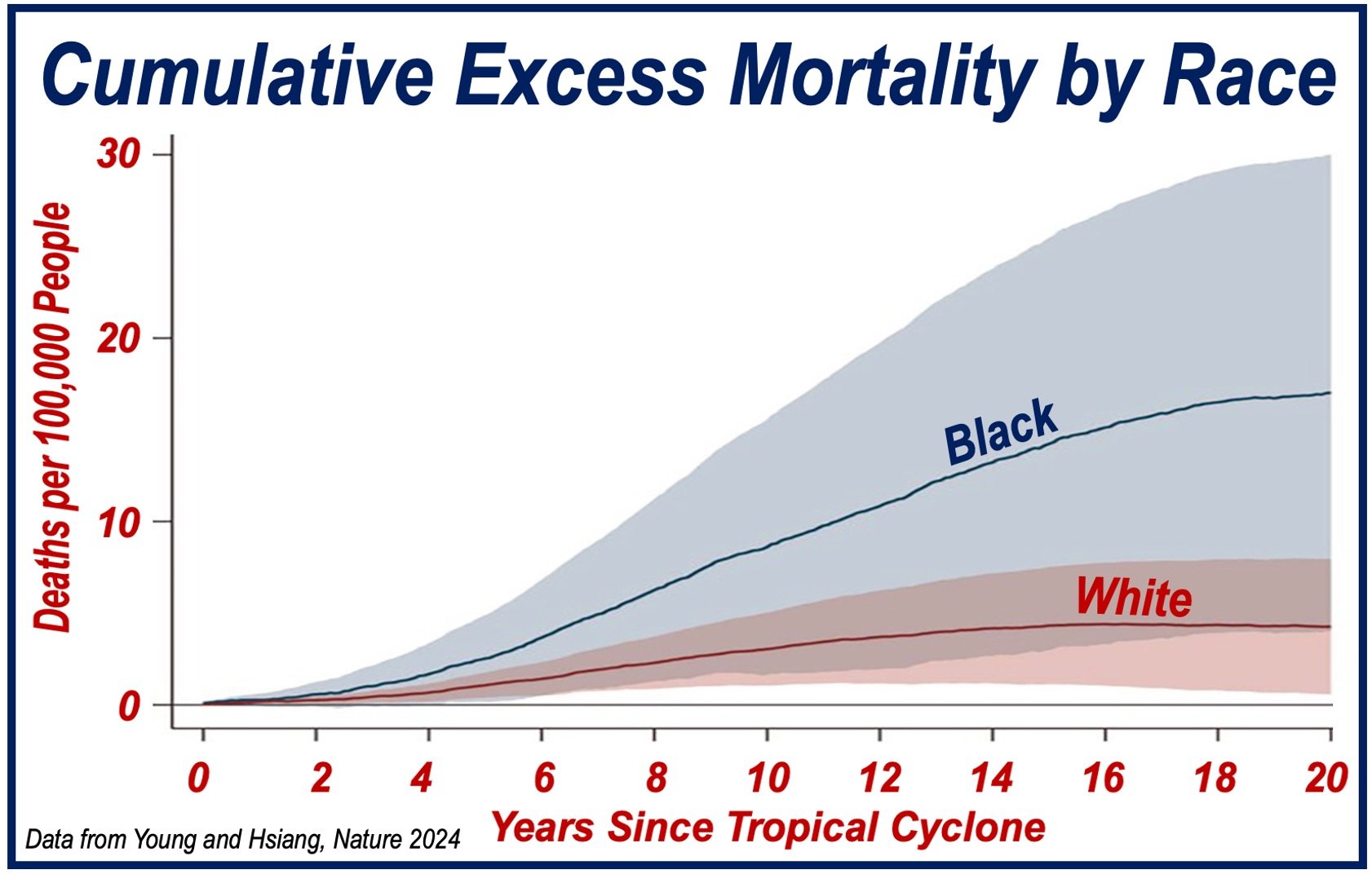While hurricanes and tropical storms are known for their immediate destructive power, new research reveals that the true human cost extends far beyond the storm’s initial devastation.
According to studies, these tropical cyclones indirectly cause thousands of deaths for up to 15 years after they strike. Understanding these long-term effects is essential for preparing communities and reducing the future health impacts of climate change-fueled storms.
Hurricanes, Tropical Storms, and Tropical Cyclones
These terms should not be used interchangeably – they have distinct meanings.
-
Hurricanes
Hurricanes are powerful tropical storms with winds exceeding 74 mph, usually forming over warm ocean waters and causing heavy rain, wind, and flooding.
-
Tropical Storms
Tropical storms are cyclones with wind speeds between 39-73 mph, less intense than hurricanes but still capable of causing damage and flooding.
-
Tropical Cyclones
Tropical cyclones are rotating storm systems, including hurricanes and tropical storms, that develop over warm oceans and cause strong winds, rain, and flooding.
Note: Hurricanes and tropical storms are tropical cyclones, but not all tropical cyclones are hurricanes (or tropical storms).
Immediate vs. Long-Term Deaths
Official statistics typically count only the direct deaths that occur during hurricanes—such as those caused by drowning or trauma, which average around 24 per storm.
However, a recent study published in Nature (citation below) shows a much larger hidden toll.
Researchers estimate that each tropical cyclone indirectly leads to an additional 7,000 to 11,000 hurricane deaths over the years following the event.
This means that, since 1930, tropical cyclones may have caused between 3.6 million and 5.2 million deaths in the United States—far more than the government’s official figure of 10,000 deaths.

Health Impacts Beyond the Storm
The study suggests that the cascading effects of hurricanes—such as displaced families, destroyed social networks, and strained public health systems—lead to increased mortality rates long after the storm has passed.
People in affected communities are dying earlier than they would have if the storm had not occurred, as explained by Solomon Hsiang, a professor at Stanford University.
The impacts are especially pronounced in communities that experience hurricanes less frequently. These areas are often less prepared for the long-term health consequences.
“Because this long-run effect on mortality has never been documented before, nobody on the ground knew that they should be adapting for this,” said Rachel Young, a Ciriacy-Wantrup Postdoctoral Fellow at the University of California, Berkeley, the study’s lead author.
Hurricane Deaths – Vulnerable Populations
The study also uncovers significant disparities in how storms affect different demographic groups.
Black Americans are three times more likely to die after a hurricane than white individuals.
Additionally, the research finds that 25% of infant deaths and 15% of deaths among people aged 1 to 44 are related to tropical cyclones.
Many of these deaths occur years after the storm, with economic strain and poor maternal health cited as key factors.
These findings underscore the long-standing concerns raised by many communities of color about unequal recovery efforts and the disproportionate challenges they face after natural disasters.

The Role of Climate Change
With climate change expected to make tropical cyclones more intense, this hidden death toll could grow.
Warmer sea surface temperatures are contributing to stronger storms, and experts predict that hurricanes will continue to become more hazardous in the coming decades.
The study’s results offer valuable insights for governments and policymakers as they work to build climate resilience in coastal areas and improve disaster management strategies.
Moving Toward Solutions
Addressing the long-term health impacts of hurricanes requires a deeper understanding of the complex chain of events that follow these storms.
The Global Policy Laboratory at Stanford University, where Hsiang works, is continuing to study why tropical cyclones lead to such prolonged increases in mortality.
Researchers believe that better communication with affected families and governments is crucial.
For example, allocating additional resources for healthcare in the years following a disaster could make a significant difference, particularly for vulnerable groups like older people, communities of color, and mothers.

Hurricane Deaths – Final Thoughts
The lasting death toll of tropical cyclones represents a significant, previously underestimated public health challenge.
As climate change continues to fuel stronger hurricanes, understanding and addressing the long-term consequences will be key to saving lives in the future.
By planning for the extended impacts of these storms, society can work to reduce the hidden death toll and protect communities most at risk.
Citation
Young, R., Hsiang, S. Mortality caused by tropical cyclones in the United States. Nature (2024). https://doi.org/10.1038/s41586-024-07945-5
